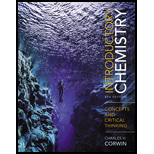
Concept explainers
(a)
Interpretation:
The following metric-English conversions are to be performed.
Concept introduction:
Metric system is a measurement system which has units of meter, liter and gram as the units for measuring length, volume and mass. Adoption of the metric system as a universal system of measurement has been resisted by several countries. In science, measurements are regularly recorded in metric units.
Answer to Problem 22E
The value of
Explanation of Solution
The value of
The conversion factor can be written as
The conversion of
The value of
(b)
Interpretation:
The following metric-English conversions are to be performed.
Concept introduction:
Metric system is a measurement system which has units of meter, liter and gram as the units for measuring length, volume and mass. Adoption of the metric system as an universal system of measurement has been resisted by several countries. In science, measurements are regularly recorded in metric units.
Answer to Problem 22E
The value of
Explanation of Solution
The value of
The conversion factor can be written as
The conversion of
The value of
(c)
Interpretation:
The following metric-English conversions are to be performed.
Concept introduction:
Metric system is a measurement system which has units of meter, liter and gram as the units for measuring length, volume and mass. Adoption of the metric system as an universal system of measurement has been resisted by several countries. In science, measurements are regularly recorded in metric units.
Answer to Problem 22E
The value of
Explanation of Solution
The value of
The conversion factor can be written as
The conversion of
The value of
(d)
Interpretation:
The following metric-English conversions are to be performed.
Concept introduction:
Metric system is a measurement system which has units of meter, liter and gram as the units for measuring length, volume and mass. Adoption of the metric system as an universal system of measurement has been resisted by several countries. In science, measurements are regularly recorded in metric units.
Answer to Problem 22E
The value of
Explanation of Solution
The value of
The conversion factor can be written as
The conversion of
The value of
Want to see more full solutions like this?
Chapter 2 Solutions
Introductory Chemistry: Concepts and Critical Thinking Plus MasteringChemistry with eText -- Access Card Package
- A bicycle accelerates from 5 miles per hour to 15 miles per hour. Does its energy increase or decrease? Is the change in potential energy or kinetic energy?arrow_forwardGiven that one metric ton = 1000 kg, how many metric tons are inlb?arrow_forwardComplete the following table by filling in the blanks in each row with the name of the metric unit, the property being measured (mass, length, volume), and/or the abbreviation for the metric unit. The first row has been completed as an example.arrow_forward
- In a recent Grand Prix, the winner completed the race with an average speed of 229.8 km/h. What was hisspeed in miles per hour and feet per second?arrow_forwardAt what temperature would 250 mL of water boil? 1000 mL? Is the boiling point an intensive or extensive property? Explain.arrow_forwardIf amigrating loon flies at an average speed of 14 m/s, what is itsaverage speed in mi/hr?arrow_forward
- Finally, sometimes the desired value does not directly match the units given but is derived from the calculation required. For example, a sheet of metal that has a volume of 45.5 cm3 has a width of 14.8 cm and has a length 15.9 cm. What is the thickness (that is, the height) of the metal sheet in millimeters?arrow_forwardIf a bullet travels at 689.0 m/s, what is it speed in miles per hour ?arrow_forwardheight of 100ml graudated cylinder in cm is 24.0 cm, what is it in m, inches, km, feet showing workarrow_forward
- If I wanted to convert 34.5 meters in to km which of the following conversions factors would I need?arrow_forwardThe diagram in (a) shows a compound made up of atoms of two elements (represented by the green and red spheres) in the liquid state.Which of the diagrams in (b) to (d) represent a physical change, and which diagrams represent a chemical change?arrow_forwardAn individual weighs 135 lb and is 5 ft 4 in. tall. What are the persons equivalent measurements in kilograms and meters?arrow_forward
 Introductory Chemistry: A FoundationChemistryISBN:9781337399425Author:Steven S. Zumdahl, Donald J. DeCostePublisher:Cengage Learning
Introductory Chemistry: A FoundationChemistryISBN:9781337399425Author:Steven S. Zumdahl, Donald J. DeCostePublisher:Cengage Learning Introductory Chemistry: An Active Learning Approa...ChemistryISBN:9781305079250Author:Mark S. Cracolice, Ed PetersPublisher:Cengage Learning
Introductory Chemistry: An Active Learning Approa...ChemistryISBN:9781305079250Author:Mark S. Cracolice, Ed PetersPublisher:Cengage Learning Chemistry: Principles and ReactionsChemistryISBN:9781305079373Author:William L. Masterton, Cecile N. HurleyPublisher:Cengage Learning
Chemistry: Principles and ReactionsChemistryISBN:9781305079373Author:William L. Masterton, Cecile N. HurleyPublisher:Cengage Learning General, Organic, and Biological ChemistryChemistryISBN:9781285853918Author:H. Stephen StokerPublisher:Cengage LearningChemistry: Matter and ChangeChemistryISBN:9780078746376Author:Dinah Zike, Laurel Dingrando, Nicholas Hainen, Cheryl WistromPublisher:Glencoe/McGraw-Hill School Pub Co
General, Organic, and Biological ChemistryChemistryISBN:9781285853918Author:H. Stephen StokerPublisher:Cengage LearningChemistry: Matter and ChangeChemistryISBN:9780078746376Author:Dinah Zike, Laurel Dingrando, Nicholas Hainen, Cheryl WistromPublisher:Glencoe/McGraw-Hill School Pub Co





